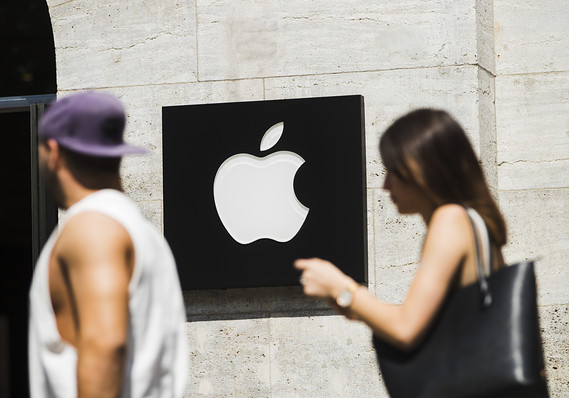
Apple down sharply on China worries
Major benchmarks closed lower Monday as tech weakness prevented stocks from holding on to earlier gains. Investors also remained cautious following last week’s equity-market rout, sparked in part by rising U.S. interest rates.
Nasdaq was the worst performer of the three after large-cap tech shares including Apple Inc. AAPL, -2.14% Alphabet Inc. GOOGL, -1.62% GOOG, -1.61% Microsoft Corp. MSFT, -1.80% and Amazon.com Inc. AMZN, -1.55% all fell more than 1%.
How did major benchmarks fare?
The Dow Jones Industrial Average DJIA, -0.35% reversed direction to fall 89.44 points, or 0.4%, to 25,250.55 while the S&P SPX, -0.59% slid 16.34 points, or 0.6%, to close at 2,750.79. The Nasdaq Composite COMP, -0.88% fell 66.15 points, or 0.9%, to finish at 7,430.74.
On Friday, the DJIA, -0.35% Dow Jones Industrial Average DJIA, -0.35% gained 287.16 points, or 1.2%, to 25,339.99, in whipsaw trading. The S&P 500 SPX, -0.59% rose 1.4% to 2,767.13, snapping a six-day losing streak and the Nasdaq Composite Index COMP, -0.88% rose 2.3%, in its best daily performance since March 26. But for the week, the Dow fell 4.2%, the S&P lost 4.1% and the Nasdaq shed 3.7%, representing their worst weekly performances since March.
What drove the market?
Investors remain spooked after last week’s two-day selloff that at its worst wiped 1,400 points off the Dow, and pushed the Nasdaq toward correction territory. Losses were tied to jitters over a sudden rise in interest rates, as the yield on the 10-year Treasury note TMUBMUSD10Y, +0.45% hit a seven-year high above 3.25% last week. That yield was hovering at 3.15% on Monday.
Higher yields raise borrowing costs for corporations and lure investors away from perceived riskier asset such as stocks. Yields move inversely to price.
Seen as a major driver for stocks, third-quarter earnings season gets under way in earnest this week, with Goldman Sachs Group Inc. GS, +0.63% among the big bank names reporting, while streaming video group Netflix Inc. NFLX, -1.89% will also be a highlight.
Geopolitical tensions were another worry for investors, starting with Saudi Arabia, which is locked in a diplomatic spat with the U.S. On Sunday, President Donald Trump threatened “severe punishment” for the Saudis if any connection was found between the kingdom and a missing dissident journalist. That country responded with an immediate threat to retaliate, sparking a rally for oil prices.
Those oil gains were pared, however, as Trump appeared to soften his tone on the controversy, suggesting “rogue killers” could be involved.
Investors are also parsing comments made in a “60 Minutes” interview Sunday night, when Trump threatened a third round of tariffs on China, which he said doesn’t “have enough ammunition to retaliate.”
What economic data were on tap?
U.S. retail sales rose 0.1% in September, less than expected. Excluding car sales, the figure remained flat last month.
The Empire State Index meanwhile rose 2.1 points to 21.1 in October, compared with 19 previously. Business inventories for August rose 0.5%.
What were analysts saying?
Investors should look to recent history if they want to know where markets are headed in coming weeks, said Thomas Martin, senior portfolio manager with GLOBALT Investments. He argued that the same factors that triggered February’s stock market correction: fears over rising rates and inflation and a resultant shift from growth to value stocks—are those which led to last week’s rout. But just as they did in late February and March, rates “have taken a big move back down,” from last week’s highs, he said. “We’re now in a phase where markets are digesting these new levels, and if earnings continue to impress,” another march higher similar to what happened in the spring could be in store.
Investors need two things to keep buying the dips in the stock market, said Hussein Sayed, chief market strategist at FXTM, in a note to clients.
“One, which is the most important, is corporate profits must remain robust and beat the 20% earnings growth projected for the third quarter while painting a rosy outlook for the quarters to come. Two, the U.S. and China need to cut a deal on trade, said Sayed. “If those two criteria aren’t met, then stocks might have already peaked for 2018.”
What stocks were in focus?
Bank of America Corp. BAC, -1.90% reported third quarter results that beat expectations ahead of the New York market open, showing earnings per share of 66 cents versus the consensus expectations of 62 cents. Shares fell1.9%, partly due to flat loan growth.
Apple AAPL, -2.14% slumped 2.1% after Goldman Sachs’ analyst Rod Hall warned that slower demand in China for iPhones could hurt sales and jeopardize the company meeting Wall Street’s earnings expectations.
Shares of Sears Holdings Corp. SHLD, -23.83% sank nearly 24% after the iconic retailer filed early Monday for bankruptcy protection from creditors. The chapter 11 filing comes after the company reached a deal with lenders that will allow it to keep hundreds of stores open for now.
Shares of Dell TechnologiesInc. rose 0.5%, while VMware Inc. shares shed 2.5%. Billionaire investor Carl Icahn on Monday disclosed he had boosted his stake in shares that track Dell Technologies’ DVMT, +0.53% interest in VMware VMW, -2.50% to 8.3%. In a letter, he said he plans to vote against Dell Technologies’ plan to buy the stock.
How were other markets trading?
Shares in Asia finished lower, failing to pick up the baton from the U.S. on Friday, led by a 1.9% drop for the Nikkei 225 index NIK, +1.25% Major European indexes were weaker across the board.
Crude-oil prices ended modestly higher, while gold GCZ8, +0.20% settled higher and the U.S. dollar index DXY, -0.05% was down 0.2%.


